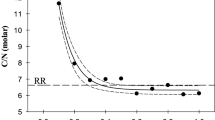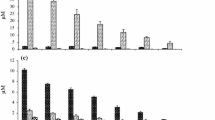Abstract
Skeletonema costatum was grown in chemostats under ammonium or silicate limitation to examine its growth kinetics and changes in cellular chemical composition at different steady-state growth rates. When the relationship between the effluent limiting substrate concentration and steady-state growth rates was examined, deviations from the simple hyperbolic form of the Monod growth equation were noted at low and high dilution rates. The data from the plot of growth rate and substrate concentration were divided into 4 regions and the relationship of these region to cell quota is discussed. Two physiological states were identified. All populations grown at D<0.05 h-1, regardless of the size of the cells or the magnitude of Q, exhibited a maximal growth rate of approximately 0.05 h-1, while populations grown at higher dilution rates (D>0.06 h-1 to 0.14 h-1). The maximal value of growth rate is obtained only in cultures grown at very high dilution rates where nutrient shift-up appears to occur, the cell quota approaches a maximum and the heterogeneous cell population becomes more homogeneous.
Similar content being viewed by others
Literature Cited
Bremer, H. and P.P. Dennis: Transition period following a nutritional shift-up in the bacterium Escherichia coli B/r: Stable RNA and protein synthesis. J. theor. Biol. 52, 365–382 (1975)
Busby, W.F. and J. Lewin: Silicate uptake and silica shell formation by synchronously dividing cells of the diatom Navicula pelliculosa (Bréb.) Hilse. J. Phycol. 3, 127–131 (1967)
Button, D.K., S.S. Dunker and M.L. Morse: Continuous culture of Rhodotorula rubra: kinetics of phosphate-arsenate uptake, inhibition and phosphate limited growth. J. Bact. 113, 599–611 (1973)
Caperon, J.: Population growth response of Isochrysis galbana to nitrate variation at limiting concentration. Ecology 49, 866–872 (1968)
— and J. Meyer: Nitrogen-limited growth of marine phytoplankton. I. Changes in population characteristics with steady-state growth rate. Deep-Sea Res. 19, 601–618 (1972)
Conway, H.L.: The uptake and assimilation of inorganic nitrogen by Skeletonema costatum (Grev.) Cleve, 125 pp. Ph.D. Dissertation, University of Washington, Seattle 1974
—, P.J. Harrison and C.O. Davis: Marine diatoms grown in chemostats under silicate or ammonium limitation. II. Transient response of Skeletonema costatum to a single addition of the limiting nutrient. Mar. Biol. 35, 187–199 (1976)
Davis, C.O.: Effects of changes in light intensity and photoperiod on the silicate-limited continuous culture of the marine diatom Skeletonema costatum (Grev.) Cleve, 122 pp. Ph.D. Dissertation, University of Washington, Seattle 1973
—, P.J. Harrison and R.C. Dugdale: Continuous culture of marine diatoms under silicate limitation. I. Synchronized life cycle of Skeletonema costatum. J. Phycol. 9, 175–180 (1973)
Droop, M.R.: Vitamin B12 and marine ecology. IV. The kinetics of uptake, growth, and inhibition in Monochrysis lutheri. J. mar. biol. Ass. U.K. 48, 689–733 (1968)
— Vitamin B12 and marine ecology. V. Continuous culture as an approach to nutritional kinetics. Helgoländer wiss. Meeresunters. 20, 629–636 (1970)
— Some thoughts on nutrient limitation in algae. J. Phycol. 9, 264–272 (1973)
— The nutrient status of algal cells in continuous culture. J. mar. biol. Ass. U.K. 54, 825–855 (1974)
Eppley, R.W. and E.H. Renger: Nitrogen assimilation of an oceanic diatom in nitrogen-limited continuous culture. J. Phycol. 10, 15–23 (1974)
— J.N. Rogers, J.J. McCarthy and A. Sournia: Light-dark periodicity in nitrogen assimilation of the marine phytoplankters Skeletonema costatum and Coccolithus huxleyi in N-limited chemostat culture. J. Phycol. 7, 150–154 (1971)
Fuhs, G.W.: Phosphorus content and rate of growth in the diatoms Cyclotella nana and Thalassiosira fluviatilis. J. Phycol. 5, 312–321 (1969)
Harrison, P.J.: Continuous culture of the marine diatom Skeletonema costatum (Grev.) Cleve, under silicate-limitation, 140 pp. Ph.D. Dissertation, University of Washington, Seattle 1974
Herbert, D.: The chemical composition of micro-organisms as a function of their environment. Symp. Soc. gen. Microbiol. 11, 391–416 (1961)
—, R. Elsworth and R.E. Telling: The continuous culture of bacteria: a theoretical and experimental study. J. gen. Microbiol. 14, 601–622 (1956)
Kubitschek, H.E.: Introduction to research with continuous cultures, 195 pp. Englewood Cliffs, New Jersey: Prentice-Hall Inc. 1970
Müller, H.: Wachs tum und Phosphatbedarf von Nitzschia actinastroides (Lemm.) v. Goor in statischer und homokontinuierlicher Kultur unter Phosphatlimitierung. Arch. Hydrobiol. (Suppl.) 38, 399–484 (1972)
Paasche, E.: Silicon and the ecology of marine plankton diatoms. I. Thalassiosira pseudonana (Cyclotella nana) grown in a chemostat with silicate as limiting nutrient. Mar. Biol. 19, 117–126 (1973a)
— Silicon and the ecology of marine plankton diatoms. II. Silicate-uptake kinetics in five diatom species. Mar. Biol. 19, 262–269 (1973b)
Parsons, T.R., K. Stevents and J.D.H. Strickland: On the chemical composition of eleven species of marine phytoplankton. J. Fish. Res. Bd. Can. 18, 1001–1016 (1961)
Pavlou, S.P., G. Friederich and J.J. MacIsaac: Quantitative determination of total organic nitrogen and isotope enrichment in marine phytoplankton. Analyt. Biochem. 61, 16–24 (1974)
Rhee, G.: Phosphate uptake under nitrate limitation by Scenedesmus sp. and its ecological implications. J. Phycol. 10, 470–475 (1974)
Schaechter, M.: Growth: cells and populations. In: Biochemistry of bacterial cell growth, pp 136–162. Ed. by J. Mandelstom and K. McQuillen. New York: Wiley Press 1968
Thomas, W.H. and A.N. Dodson: On nitrogen deficiency in tropical Pacific oceanic plankton. II. Photosynthetic and cellular characteristics of a chemostat grown diatom. Limnol. Oceanogr. 17, 515–523 (1972)
Williams, F.M.: Population growth and regulation in continuously cultured algae, Ph.D. Thesis, Yale University 1965
Author information
Authors and Affiliations
Additional information
Communicated by M.R. Tripp, Newark
Contribution No. 881 from the Department of Oceanography, University of Washington, Seattle, Washington 98195, USA. This paper represents a portion of two dissertations submitted by P.J.H. and H.L.C. to the Department of Oceanography, University of Washington, Seattle, in partial fulfillment of the requirements for the Ph.D. degree.
Rights and permissions
About this article
Cite this article
Harrison, P.J., Conway, H.L. & Dugdale, R.C. Marine diatoms grown in chemostats under silicate or ammonium limitation. I. Cellular chemical composition and steady-state growth kinetics of Skeletonema costatum . Marine Biology 35, 177–186 (1976). https://doi.org/10.1007/BF00390939
Accepted:
Issue Date:
DOI: https://doi.org/10.1007/BF00390939




